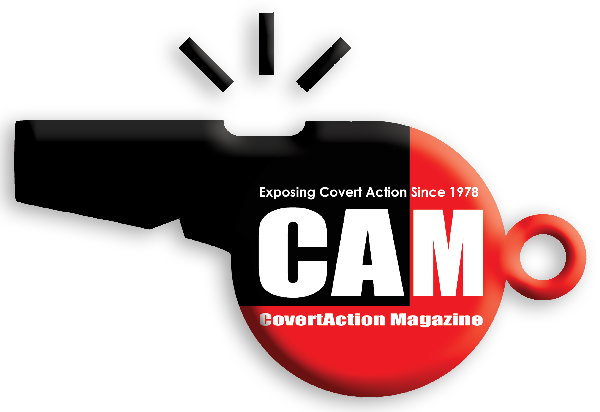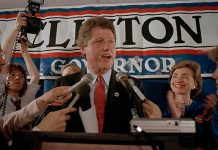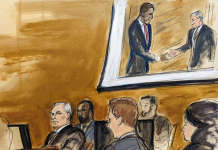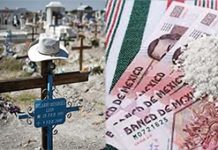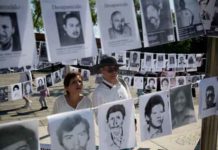
A darling of the Bush II and Obama administrations, Álvaro Uribe Vélez has had close connections to the Medellín and Cali drug cartels along with fascist paramilitary groups that committed heinous crimes in a war against left-wing guerrillas
In late July, former Colombian President Álvaro Uribe Vélez (2002-2010) was sentenced to 12 years of house arrest after being convicted on bribery and fraud charges. Uribe’s conviction was historic because it was the first of a Colombian president.
The heart of the case centered on Uribe’s attempt to bribe a witness to change damaging testimony that implicated him with paramilitary groups that committed egregious war crimes in the suppression of the leftist Fuerzas Armada Revolucionario de Colombia (FARC).
A 1991 Defense Intelligence Agency (DIA) report had identified Uribe as being dedicated to collaboration with the Medellín drug cartel. Eight years earlier, Uribe had been removed from his position as mayor of Medellín after he attended a drug cartel meeting at Pablo Escobar’s ranch.[1]

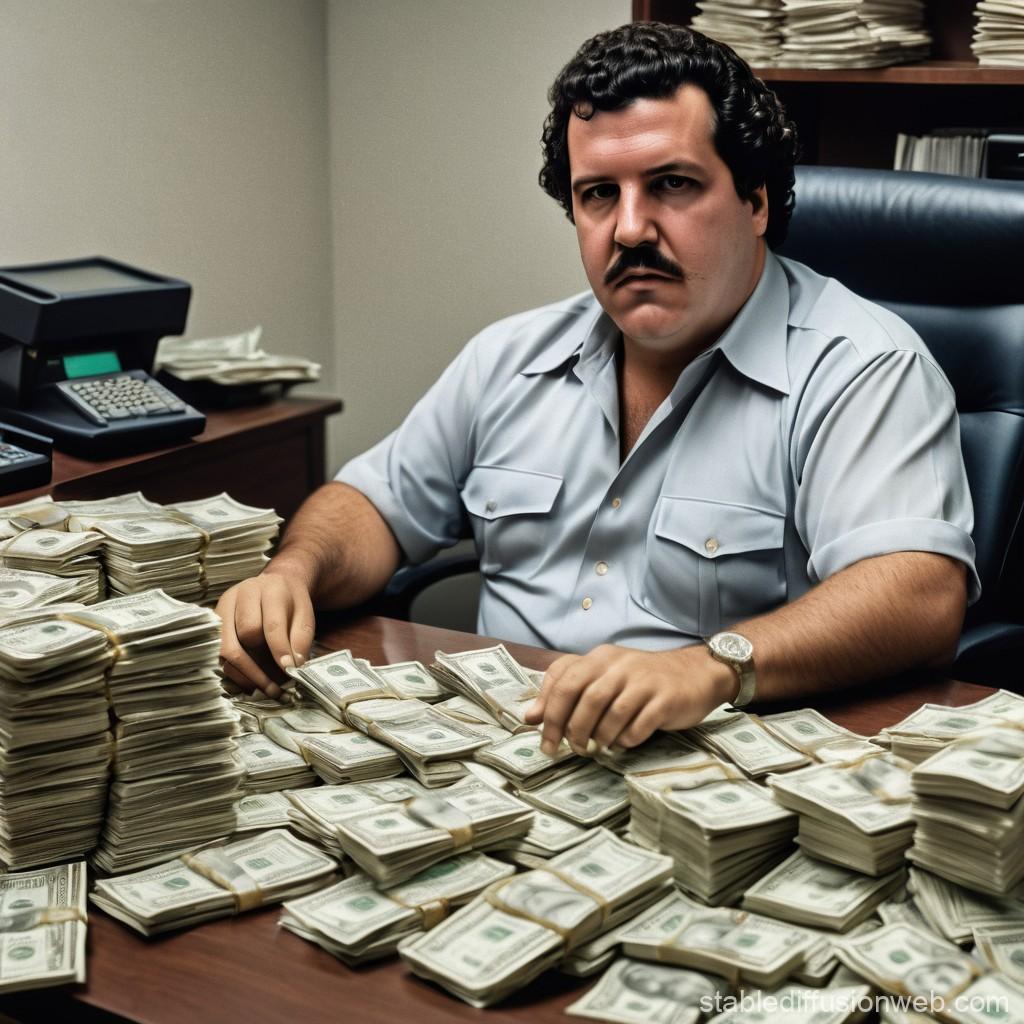
The New York Times and other media characteristically reported on Uribe’s conviction without addressing his ties to Colombia’s underworld, nor the massive amount of U.S. aid that he received while president under Plan Colombia.
Plan Colombia was a $10 billion militarized drug-war program first implemented in 2000 by the Clinton administration—with strong support from Joe Biden.
Much of the military equipment provided to Uribe’s government under Plan Colombia was used to combat the FARC which was conveniently branded as “narco-guerrillas”—though in reality the drug cartels allied closely with the right-wing paramilitaries to which Uribe has been linked, and hated the FARC, which threatened to expropriate their land.
Carlos Castaño, Colombia’s chief paramilitary leader and a reported CIA asset, stated that 70% of the income for his group, called the United Self Defense Forces of Colombia (AUC) and a de-facto wing of the Colombian army which carried out 70-80% of non-combat killings, came from drugs.[2]
Castaño was close with the powerful Henao-Montoya drug-trafficking cartel and was indicted by the U.S. Department of Justice in September 2002, charged with trafficking more than 17 tons of cocaine.[3]
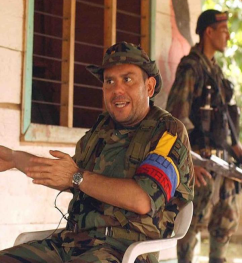
The AUC had been placed on the State Department’s list of terrorist organizations because of its role in the August 1999 assassination of TV host Jaime Garzón, who advocated for peace with leftist guerrillas.
The AUC was also implicated in the murder of dozens of trade union activists at the behest of wealthy ranchers and managers of U.S. corporations, such as Drummond Co. of Alabama, which helped transform Colombia into the world’s fourth-largest coal exporter.
Castaño’s connection to Uribe went back to the 1990s when the AUC took control of a paramilitary force that Uribe had set up as governor of Antioquia and paid to hunt down leftist guerrillas.[4]
In 2002, Castaño supported Uribe’s election, stating that he was “the man closest to our philosophy.”[5]
This is a reference to Uribe’s extreme right-wing views and desire to exterminate the FARC partly to avenge the death of his father, Alberto Uribe Sierra, at their hands on the family ranch in Antioquia in 1983.
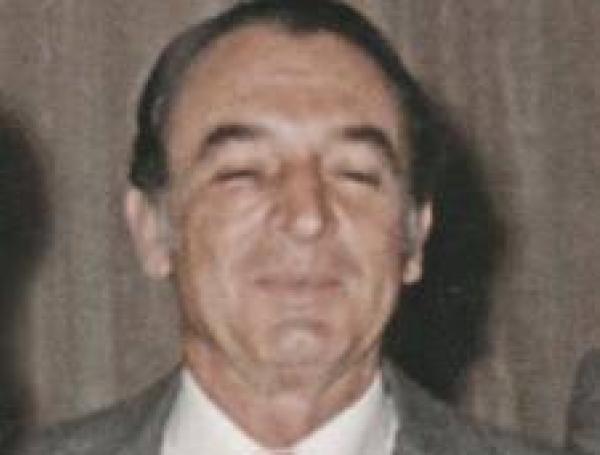
Uribe Sr. was a real-estate intermediary for drug traffickers connected by marriage to the Ochoas (founders of the Cali cartel), who helped his son establish contacts with the drug cartels after forming an aviation company, Aerocivil.[6]
When Alvaro was appointed as director of civil aeronautics in the 1980s, he granted airplane licenses to known drug traffickers and members of their families, including Carlos Lehder Rivas and José Gonzalo Rodríguez Gacha, a Medellín drug-cartel lord.
Uribe’s brother Santiago was head of a paramilitary group known as the 12 Apostles, which was set up in the 1990s with the aim of killing those considered to be “social undesirables,” including sex workers and drug addicts, as well as those perceived to be linked to “subversive groups,” such as FARC guerrillas, operating in the Yarumal area of Antioquia.[7]
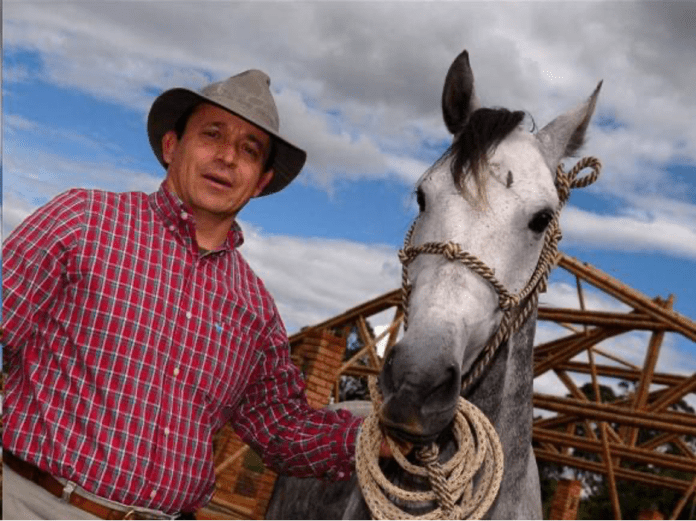
After becoming Colombia’s president in 2002, Uribe enacted an intensive drive against the FARC that turned the country into a graveyard. Between 2002 and 2008, 6,402 civilians killed by the army were counted as guerrillas in what became known as the “false positives” scandal.[8]
Uribe also sanctioned an aerial defoliation program which drove villagers away from FARC-controlled areas and made way for mega-projects benefiting multinational corporations.

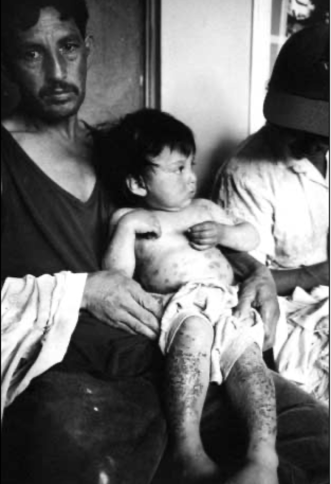
Glyphosate or Roundup weed killer, manufactured by Monsanto, one of the companies responsible for manufacturing Agent Orange during the Vietnam War, was sprayed at 100 times the concentration allowed in the U.S., causing serious health and environmental consequences for local residents.
Professor Ryan E. Holroyd has written that, from 2002 to 2006, the first four years of Uribe’s presidency, the Colombian government received an average of $572 million per year in military-police aid from the U.S., compared to an average of $304 million from 1997 to 2001.
The number of Colombian Army officers trained in U.S. military academies increased fivefold during the same time, and the number of U.S. mercenaries operating in the country tripled.[9]
During a 2006 press briefing with Uribe, President George W. Bush said that he was personal friends with Uribe and that every time he visited with him he was “impressed by his strength of character.” Subsequently, Bush awarded Uribe with the Presidential Medal of Freedom.
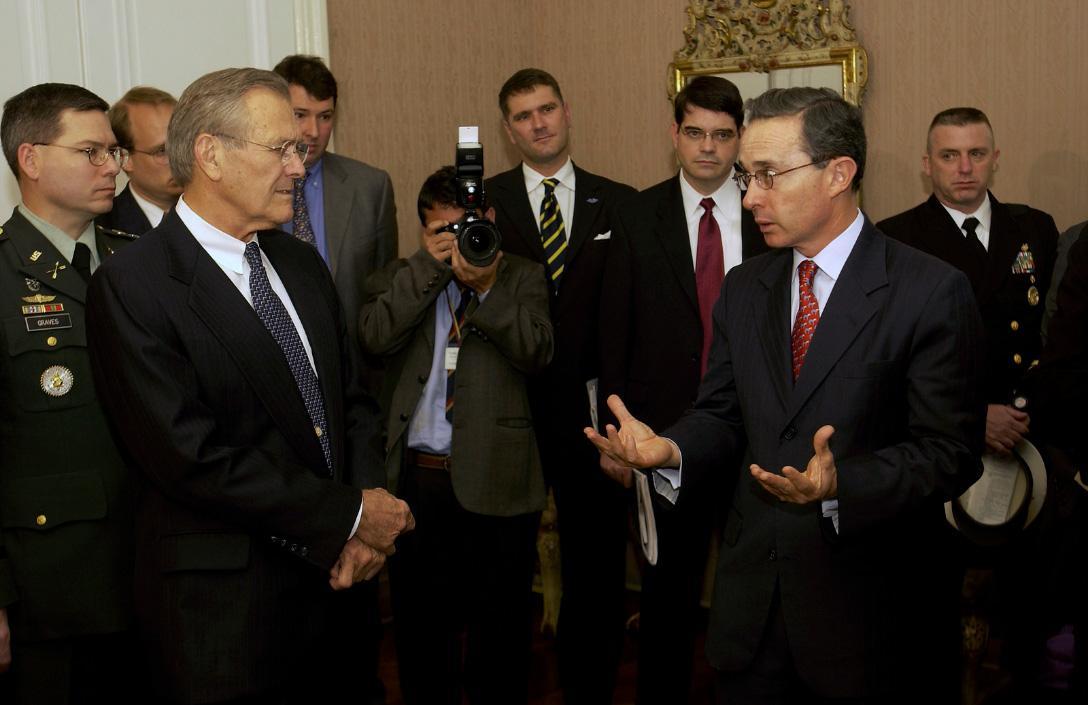
CIA Director Robert Gates called Uribe a “great hero,” while Barack Obama said that Uribe had “performed admirably on a range of fronts” with “diligence and courage.”[10]
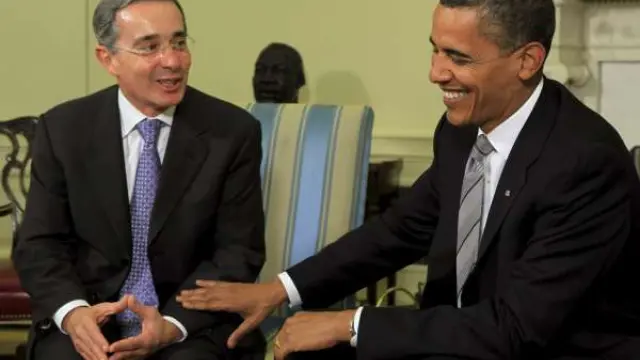
The above remarks appear preposterous in light of Uribe’s recent conviction—along with what we know about the atrocities engendered by his hard-line policies toward the FARC.
Unfortunately, the U.S. has a pattern of supporting corrupt public officials like Uribe who adopt right-wing policies that benefit U.S. multi-national corporations.
Supporting a significant U.S. military presence in Colombia, Uribe privatized pension funds, health care and social security and dismantled labor laws and protection of workers rights while supporting an IMF structural adjustment program that deepened poverty levels in Colombia.[11]
Uribe’s contemporaries include Honduran President Juan Orlando Hernández, former Panamanian strongman Manuel Noriega, and Peruvian President Alberto Fujimori and intelligence chief Vladimiro Montesinos.
They were all U.S. drug-war “partners” convicted on drug trafficking or related corruption charges who embody the stark double-standards underlying the drug war’s failure.
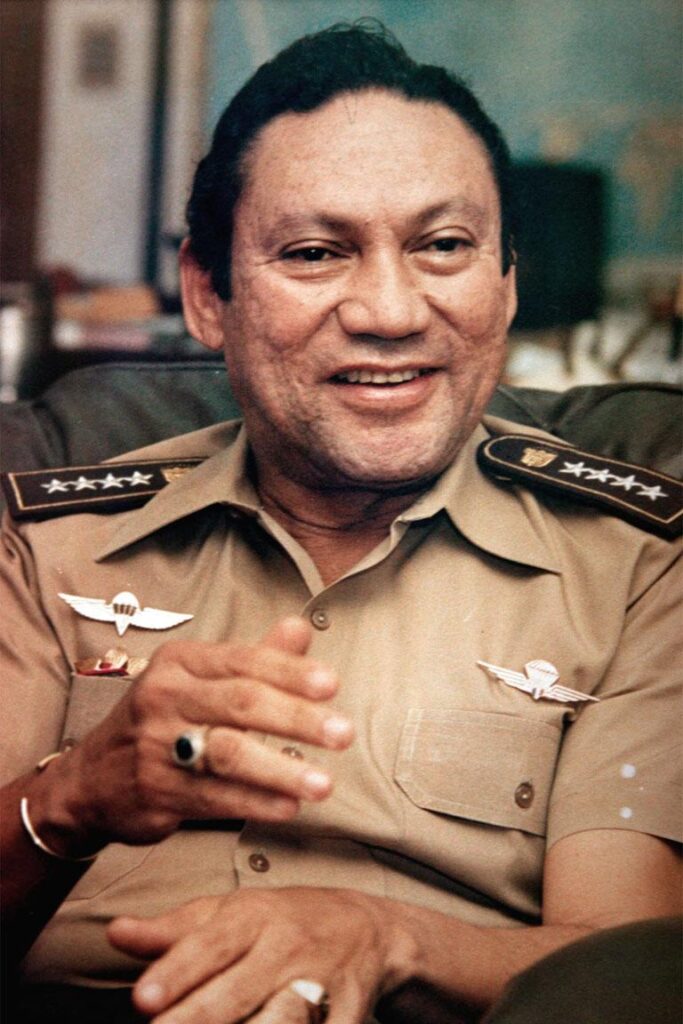
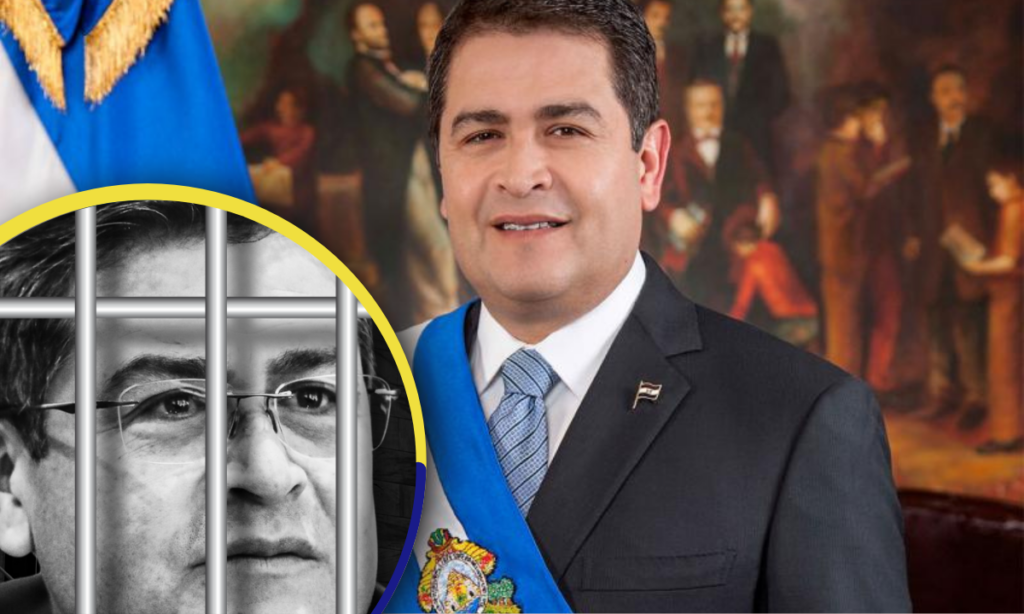

The Trump administration has recently placed a $50 million bounty on the head of Venezuela’s socialist president Nicholas Maduro, whom the U.S. government has long accused–without providing any hard proof–of collaborating with FARC and Mexican drug cartels to traffic cocaine into the U.S.
Mexican President Claudia Sheinbaum was among those to assert that the charges against Maduro were baseless.
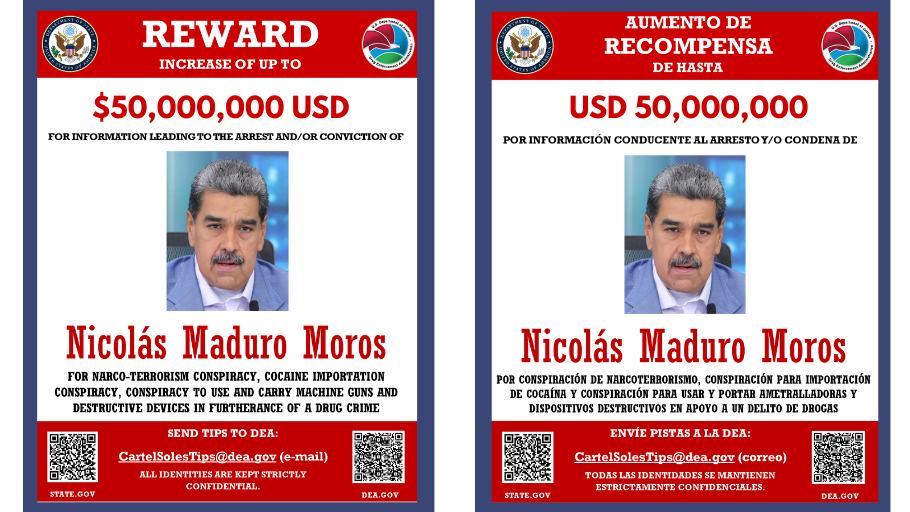
During the Cold War, the U.S. repeatedly accused the Cuban government and other socialist countries of trafficking in drugs, which we also know to be untrue.
Never widely publicized was the fact that the exportation of illegal drugs from Colombia and other South American countries increased under right-wing leaders like Uribe despite all the resources devoted to combating it.[12]
The real underlying purpose of the War on Drugs in Colombia was to help destroy the FARC, for which Uribe is still receiving credit in U.S. media outlets reporting on his conviction.
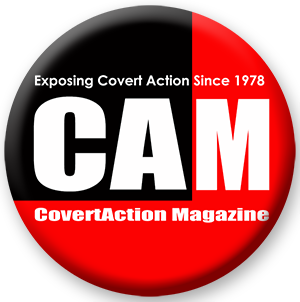
Oliver Villar and Drew Cottle, Cocaine, Death Squads, and the War on Terror: U.S Imperialism and Class Struggle in Colombia (New York: Monthly Review Press, 2011), 61. The U.S. Embassy had been informed that Uribe’s Senate campaign in the early 1990s was funded by the Medellín cartel. ↑
Peter Dale Scott, Drugs, Oil, and War: The United States in Afghanistan, Colombia, and Indochina (New York: Rowman & Littlefield, 2003), 74. ↑
Scott, Drugs, Oil, and War, 75. ↑
Villar and Cottle, Cocaine, Death Squads, and the War on Terror, 61; “Colombia: Former President Uribe Convicted in Paramilitary Bribery Case,” National Security Archive, The George Washington University, July 29, 2025. The head of Uribe’s militia, Pedro Juan Moreno Villa, was a leading importer of potassium permanganate, the main chemical used in the manufacture of cocaine. ↑
Ryan E. Holroyd, “The Twilight of the Colombian Paramilitary,” Past Imperfect, 17 (2011). Uribe’s ranch shared a boundary with the property of AUC commander Salvatore Mancuso. Uribe and his father were wealthy cattle ranchers whose ranch was a headquarters for deadly paramilitary groups in the region. ↑
Villar and Cottle, Cocaine, Death Squads, and the War on Terror, 60, 61. ↑
When Santiago was put on trial, there was a reported pattern of intimidation and killing of witnesses. Another of Uribe’s brothers, Jaime, married into the Cifuentes Villa crime family, which is linked to both the Sinaloa and Medellín drug cartels. Santiago’s death squad was similar to those backed by the CIA in the dirty war against leftists in El Salvador, Guatemala and Nicaragua in the 1980s. ↑
Additionally, Uribe had overseen massacres committed during his time as governor of Antioquia. ↑
Holroyd, “The Twilight of the Colombian Paramilitary”; Doug Stokes, America’s Other War: Terrorizing Colombia (London: Zed Books, 2005), 105. ↑
Jeremy Kuzmarov, Obama’s Unending Wars: Fronting the Foreign Policy of the Permanent Warfare State (Atlanta: Clarity Press, 2019), 292. ↑
Villar and Cottle, Cocaine, Death Squads, and the War on Terror. ↑
Villar and Cottle, Cocaine, Death Squads, and the War on Terror. ↑
CovertAction Magazine is made possible by subscriptions, orders and donations from readers like you.
Blow the Whistle on U.S. Imperialism
Click the whistle and donate
When you donate to CovertAction Magazine, you are supporting investigative journalism. Your contributions go directly to supporting the development, production, editing, and dissemination of the Magazine.
CovertAction Magazine does not receive corporate or government sponsorship. Yet, we hold a steadfast commitment to providing compensation for writers, editorial and technical support. Your support helps facilitate this compensation as well as increase the caliber of this work.
Please make a donation by clicking on the donate logo above and enter the amount and your credit or debit card information.
CovertAction Institute, Inc. (CAI) is a 501(c)(3) non-profit organization and your gift is tax-deductible for federal income purposes. CAI’s tax-exempt ID number is 87-2461683.
We sincerely thank you for your support.
Disclaimer: The contents of this article are the sole responsibility of the author(s). CovertAction Institute, Inc. (CAI), including its Board of Directors (BD), Editorial Board (EB), Advisory Board (AB), staff, volunteers and its projects (including CovertAction Magazine) are not responsible for any inaccurate or incorrect statement in this article. This article also does not necessarily represent the views the BD, the EB, the AB, staff, volunteers, or any members of its projects.
Differing viewpoints: CAM publishes articles with differing viewpoints in an effort to nurture vibrant debate and thoughtful critical analysis. Feel free to comment on the articles in the comment section and/or send your letters to the Editors, which we will publish in the Letters column.
Copyrighted Material: This web site may contain copyrighted material the use of which has not always been specifically authorized by the copyright owner. As a not-for-profit charitable organization incorporated in the State of New York, we are making such material available in an effort to advance the understanding of humanity’s problems and hopefully to help find solutions for those problems. We believe this constitutes a ‘fair use’ of any such copyrighted material as provided for in section 107 of the US Copyright Law. You can read more about ‘fair use’ and US Copyright Law at the Legal Information Institute of Cornell Law School.
Republishing: CovertAction Magazine (CAM) grants permission to cross-post CAM articles on not-for-profit community internet sites as long as the source is acknowledged together with a hyperlink to the original CovertAction Magazine article. Also, kindly let us know at info@CovertActionMagazine.com. For publication of CAM articles in print or other forms including commercial internet sites, contact: info@CovertActionMagazine.com.
By using this site, you agree to these terms above.
About the Author

Jeremy Kuzmarov holds a Ph.D. in American history from Brandeis University and has taught at numerous colleges across the United States. He is regularly sought out as an expert on U.S. history and politics for radio and TV programs and co-hosts a radio show on New York Public Radio and on Progressive Radio News Network called “Uncontrolled Opposition.”
He is Managing Editor of CovertAction Magazine and is the author of six books on U.S. foreign policy, including Obama’s Unending Wars (Clarity Press, 2019), The Russians Are Coming, Again, with John Marciano (Monthly Review Press, 2018), Warmonger. How Clinton’s Malign Foreign Policy Launched the U.S. Trajectory From Bush II to Biden (Clarity Press, 2023); and with Dan Kovalik, Syria: Anatomy of Regime Change (Baraka Books, 2025).
Besides these books, Kuzmarov has published hundreds of articles and contributed to numerous edited volumes, including one in the prestigious Oxford History of Counterinsurgency .
He can be reached at jkuzmarov2@gmail.com and found on substack here.
